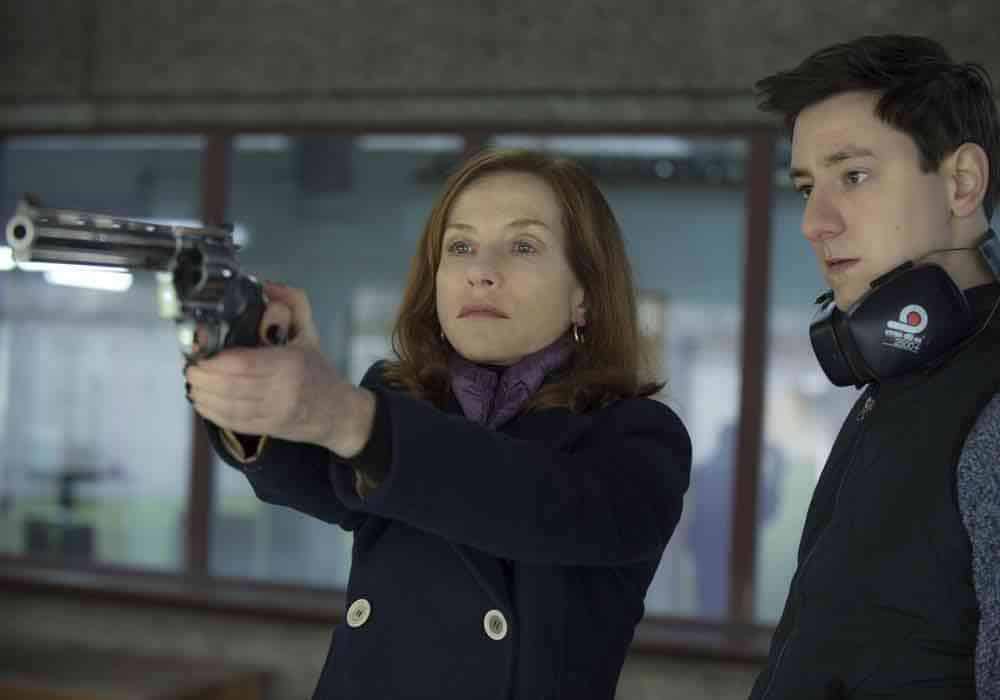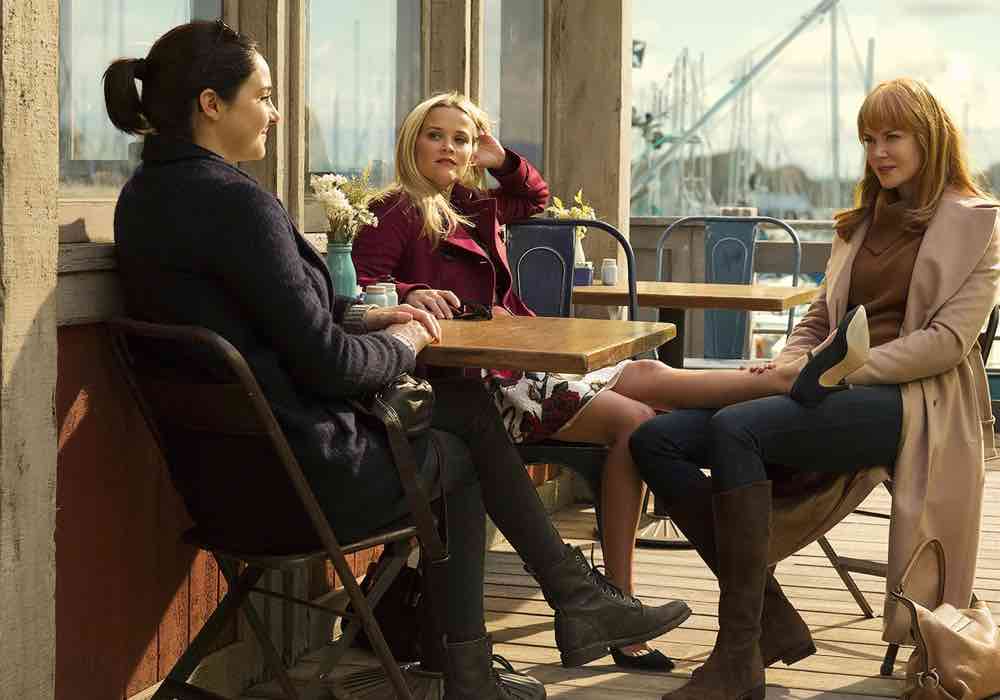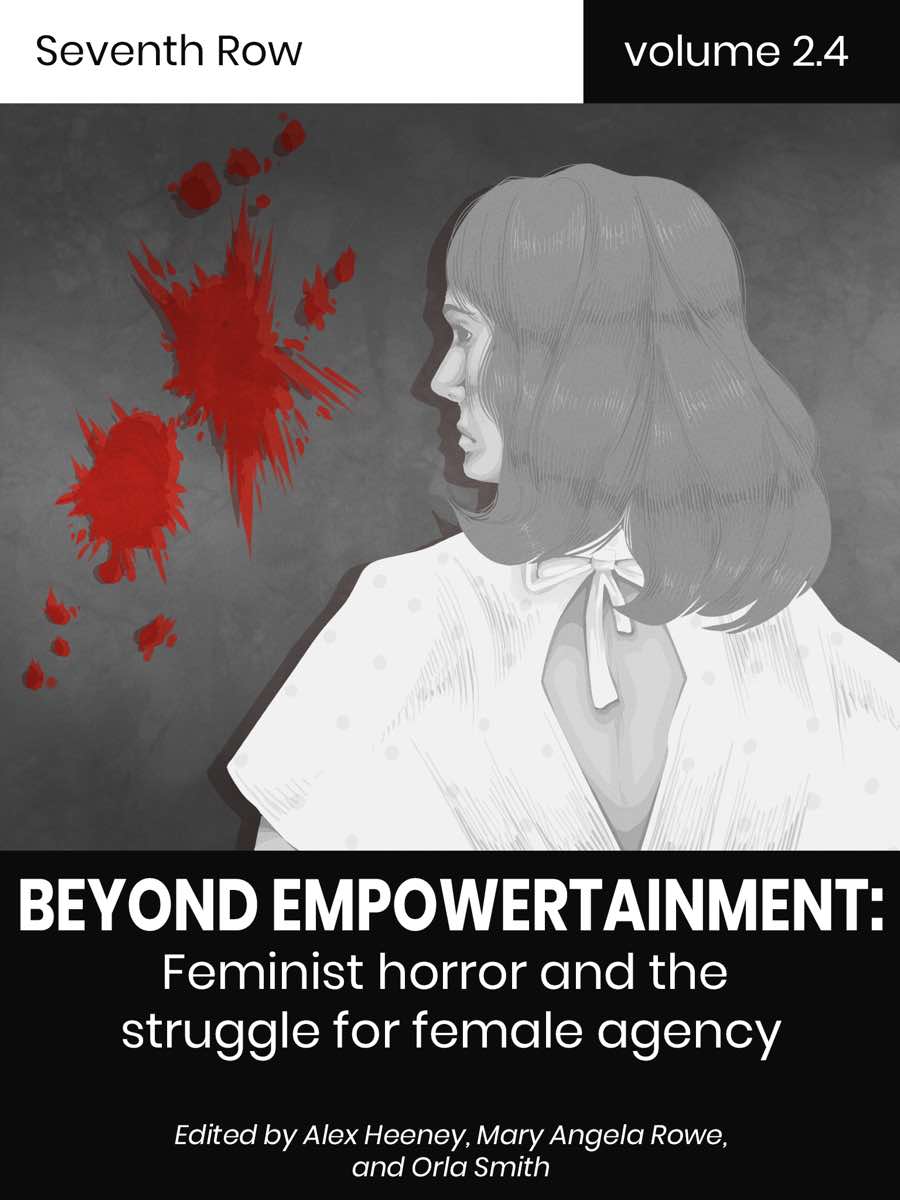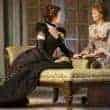Paul Verhoeven’s Elle and Jean-Marc Vallée’s Big Little Lies share the common goal of unmasking the omnipresence of misogyny via its horrific manifestations in violence. In both universes, the best protection from violent men is trusting other women.
This is an excerpt of the essay which appears in the ebook Beyond Empowertainment: Feminist Horror and The Struggle for Female Agency. Get your copy of the ebook here.

Watching Paul Verhoeven’s critically acclaimed but controversial film Elle and the Jean-Marc-Vallée-directed HBO show Big Little Lies in the same month was trying. I found myself having extremely visceral reactions with both, despite their drastically different approaches to depicting gendered violence and its effects on its victims. In Big Little Lies, the very first instance of violence between housewife Celeste (Nicole Kidman) and her husband Perry (Alexander Skarsgård), while almost tame in retrospect, got my heart racing: the soft-spoken Perry suddenly raises his voice and jumps on Celeste, grabbing her arm and seemingly stopping himself from going further. In Elle, a shiver ran down my spine when Michèle (Isabelle Huppert)’s twenty-something son Vincent started screaming at and grabbing his fiancée Josie who was standing at the top of a flight of stairs holding her baby.
[clickToTweet tweet=”‘Watching ELLE and BIG LITTLE LIES in the same month was trying. I had extremely visceral reactions.'” quote=”Watching ELLE and BIG LITTLE LIES in the same month was trying. I had extremely visceral reactions.”]
Days after watching the show, I was surprised to find myself still thinking about the impact that such graphic scenes had had on me. Even though I have never suffered that kind of violence myself, these brutal scenes felt uncomfortably close and personal. This is not only because both texts bring to life my worst fears as a woman in a patriarchal society; but also because they deliberately engage with and dismantle the workings of those terrifying situations I have only imagined finding myself in. Both also share the common goal of unmasking the omnipresence of misogyny via its horrific manifestations in violence. In both universes, the best protection from violent men is trusting other women.
In Elle, CEO Michèle, a middle-aged Parisian woman, seeks out her masked rapist’s identity. But instead of exposing him, she regains control by beginning an affair with him, while also reconfiguring to her advantage her relationships with other men in her life. In contrast, Big Little Lies, centred on five housewives in the affluent seaside city of Monterey, California, focuses on the emotional impact of gendered abuse on two women. Jane Chapman (Shailene Woodley) was raped by a stranger and raises alone her 6-year-old son born from the encounter. In parallel, housewife Celeste Wright suffers daily beatings and not-quite-consensual violent sex at the hands of her husband Perry.
Want to read the rest of the interview? Order a copy of our ebook on feminist horror beyond empowertainment here.
[wcm_restrict]
[clickToTweet tweet=”Both ELLE and BIG LITTLE LIES bring to life my worst fears as a woman in a patriarchal society.” quote=”Both ELLE and BIG LITTLE LIES bring to life my worst fears as a woman in a patriarchal society.”]
The way Michèle progresses through the story in Elle makes abstract rather than true-to-life sense. Her encounters with men are not clashes between two people with complex, human emotions, but rather conflicts of power influenced by their setting in patriarchal society. No real woman who had gone through such a traumatic experience would behave like Michèle, with such emotional detachment and apparent cool. But these confrontations between characters as ideas establish the film firmly in the fairytale mode of storytelling and turn Michèle into the symbolic She (Elle), standing in for all womankind. And as her conception of how a woman should be treated by society evolves, Michèle’s attitude towards men progressively changes.
[clickToTweet tweet=”The way Michèle progresses through the story in Elle makes abstract rather than true-to-life sense.” quote=”The way Michèle progresses through the story in Elle makes abstract rather than true-to-life sense.”]
In this misogynistic world, Michèle has internalized that women should expect to be mistreated by men. Indeed, even though she left her husband because he hit her, he’s the one who relentlessly complains about feeling abandoned and asks for her pity, and she lets him do so. The man she’s having an affair with doesn’t care that she could be repulsed by sex after her rape. And her own company makes video games filled with monsters violently raping highly sexualised women because this is the type of entertainment that sells. So Michèle quietly orders sushi right after her attack, keeps going to work, and remains as bossy as her reputation suggests — acting as though her rape didn’t hurt her at all. Michèle’s reaction may be drastic and unbelievable, but her disconnect and neutrality in the face of abuse make her the symbolic incarnation of mistreated women who have internalised the misogyny they face daily.
[clickToTweet tweet=”Michèle is the symbolic incarnation of mistreated women who have internalised the misogyny they face daily.” quote=”Michèle is the symbolic incarnation of mistreated women who have internalised the misogyny they face daily.”]
Yet the abstractness with which Michèle is characterised clashes with Verhoeven’s realistic filmmaking, the better to highlight the omnipresence of misogyny and violence in society in variously latent forms. He presents the attacks in all their brutality, the performances are naturalistic, and three quarters of the film consist simply of Michèle going about her daily tasks at work and with her family. Disturbingly, this feeling of the everyday clashes with the more abstract consideration of patriarchy. Precisely because the film is a fable about male violence, the story keeps moving along, never stopping after any of those intense moments of brutality to let the spectator breathe. Violence is presented as just another fact, another part of the everyday, on the same plane as Michèle’s conversations with people. This is Verhoeven’s point: the violence Michèle suffers is not isolated, but just an extreme symptom of the misogyny that permeates Michèle’s life.

Big Little Lies, by contrast, tackles violence against women with a more direct and thoroughly realistic approach. Vallée adapts his filmmaking style to each character and chooses a depiction of sexual violence that is true to their lived emotional experiences.
Celeste spends most of the series in denial about the horror of Perry’s abuse, so Vallée inserts Perry’s vicious strikes at Celeste in short and precise flashbacks doled out over the course of her quiet everyday life as a wealthy homemaker. Vallée spares us none of the violence but remains respectful of the reality of her experience: though she refuses to acknowledge his abuse and tries to carry on with her life, memories of his beatings keep flowing back to her. To her circle of female friends, Celeste talks about her “rough” sex with her husband, but calls it exciting rather than violent. This choice of words, together with Vallée’s editing, both highlight Celeste’s struggle to reconcile the sweetness of the life she and Perry have built with her fear and hatred of his abuse.
[clickToTweet tweet=”Vallée spares us none of the violence but remains respectful of the reality of her experience.” quote=”Vallée spares us none of the violence but remains respectful of the reality of her experience.”]
In contrast, Jane is still coping with past abuse, unable to recall the details of her attack. She’s tortured by recurring, patchy flashbacks of the night of her rape and surreal visions of herself pursuing and even shooting her unknown attacker. While Celeste is trying to deny and forget her abuse, Jane struggles to remember its details, and her imagination and vague memories make up dreamlike visions, rather than the abrupt images that Celeste keeps seeing despite herself.
The brutality of the violence in the film and the show places the spectator in these women’s shoes in a conscientious refusal to make the horror of these attacks palatable. This stands in sharp contrast to the misogynistic way violence against women is reflected in other media. Rape and violence against women in general are often used as plot devices to advance the men’s stories in films and TV shows. Game of Thrones is the most obvious culprit, but even mainstream films have that problem: the real Drive of Ryan Gosling’s silent character in Nicolas Winding Refn’s film is his desire to protect his cute neighbour Irene (Carey Mulligan) from violence.. In Nocturnal Animals, although director Tom Ford does acknowledge the horror of rape, he focuses on the husband and father of the brutalised women and portrays him (rather than them) as the victim, before devoting the rest of his film to this man’s revenge. By contrast, Verhoeven and Vallée make the sadly unusual decision to focus on the female experience of gendered violence. In Elle and Big Little Lies, graphic violence against women isn’t present as simply an exciting plot point, but instead as the starting point of an in-depth, feminist analysis of the misogynistic aspects of our society.
[clickToTweet tweet=”The brutality of the violence…is a conscientious refusal to make these attacks palatable.” quote=”The brutality of the violence…is a conscientious refusal to make these attacks palatable.”]
What Vallée really understands is how solitary and painful the experience of sexual violence is for women and why: Jane and Celeste struggle to share their stories because they are, as the latter herself eventually admits, ashamed. They both spend a lot of time alone, either at home or, in Jane’s case, running on the beach, to better hide their pain from others. Michèle also keeps her story and feelings to herself despite having a best friend in her work partner Anna (Anne Consigny), but she doesn’t show any difficulty in doing so. In fact, it may seem that Michèle doesn’t even have feelings; instead, she thinks things through. Her secretive behaviour results from her investigation into who her attacker is, rather than a sense of shame. Taken together, Jane and Celeste are like a fleshed out version of Michèle: their stories realistically reveal the emotional impact that violence continuously has on its victims. By contrast, focusing as he does on the sociological basis of rape culture, Verhoeven chooses not to depict the traumatic shame and self-doubt that are its symptoms.
Despite their different approaches, Elle and Big Little Lies meet in the mode of female resistance they argue for: naming and sharing the experience of male violence is the best way to fight it. Three episodes in, Jane finally talks about her rape to her new female friends. Celeste never really discusses her own trauma with them, but the one person she confides in is her female marriage counsellor. Similarly, in Elle, Michèle first shows such real sentiment in a key scene of confession to a woman: at long last, she admits to her best friend Anna that she was the woman with whom Anna’s husband Robert had been sleeping. Her progressive rebellion against the misogyny surrounding her has lead Michèle to realise that her compliance with Robert’s abuse was complicity with his abuse of her best friend. Anna bursts into angry tears, but soon enough, in the film’s waning moments, the two women reconcile. In both Elle and Big Little Lies, coming out of isolation by confessing to other women is the only way to relieve the pain inflicted upon them by violent and sleazy men.
[clickToTweet tweet=”In ELLE and BIG LITTLE LIES, naming and sharing the experience of male violence is the best way to fight it.” quote=”In ELLE and BIG LITTLE LIES, naming and sharing the experience of male violence is the best way to fight it.”]
In the very last moments of both the film and the show, Verhoeven and Vallée go further and present female mutual support as a form of protection, although in wildly different ways. The climactic ending of Big Little Lies not only reverses the violence against an insanely violent man, but ties all these women together in a bond of trust and collective assistance that no man can understand or threaten. However saccharine the images of the women and their kids playing on the beach may be, they are fully earned: these women are connected by the unbreakable bond created between them by the truth about Perry and about toxic masculinity, and by their need to rely on each other for survival. In Elle’s uplifting yet bittersweet denouement, Anna forgives Michèle as she announces that she’s left her unfaithful husband. Anna, operating as a symbol of female mutual support in Verhoeven’s fable, demonstrates that her trust in Michèle is now absolute by suggesting they should move in together. Michèle offers a genuine laugh, her first truly liberated and positive emotional reaction in the film. For Verhoeven, the utter incompetence of men is laughable and women are, all together, in on the joke.
You may also like…
[/wcm_restrict]


